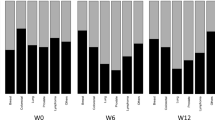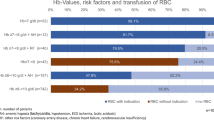Abstract
Purpose
Anemia affects most patients treated for cancer by chemotherapy. It is a known major contributor to fatigue and loss of quality of life and is likely to have a negative effect on prognosis and mortality from cancer. The main purpose of this study was to characterize the management of anemia and iron deficiency in a French oncology day-care center.
Methods
A retrospective study was conducted between May and November 2012 in the oncology day unit of the Jean Godinot Cancer Center (France). The 133 patients included were all over the age of 18 and being treated by chemotherapy and had mild, moderate, or severe anemia.
Results
Over half (58 %) the patients were shown to be receiving no specific treatment for anemia. Iron balance was assessed in 71 patients and iron deficiency diagnosed in 37. Stepwise logistic regression showed that patients with severe to moderate anemia were nearly four times more likely to have an iron balance assessment than those with mild anemia (OR, 3.78; 95 % CI, 1.84–7.76; P = 0.0003). Classical logistic regression shows that older patients (≥70) are three times less likely to have an iron balance assessment than patients <70 years (OR, 0.32; 95 % CI, 0.12–0.86; P = 0.06).
Conclusion
An ideal medical setting for the management of anemia and iron deficiency, and the associated quality-of-life concerns, has yet to be defined for patients with cancer. Screening and treatment of mild to moderate anemia are inadequate, despite the advent of erythropoiesis-stimulating agents. Large scale, multicenter studies are required to define a clear medical framework for the management of anemia and iron deficiency.



Similar content being viewed by others
References
Stone P, Richardson A, Ream E, Smith AG, Kerr DJ, Kearney N (2000) Cancer-related fatigue: inevitable, unimportant and untreatable? Results of a multi-centre patient survey. Cancer Fatigue Forum Ann Oncol 11(8):971–975
Carelle N, Piotto E, Bellanger A, Germanaud J, Thuillier A, Khayat D (2002) Changing patient perceptions of the side effects of cancer chemotherapy. Cancer 95(1):155–163
Sabbatini P (2000) Contribution of anemia to fatigue in the cancer patient. Oncology (Williston Park) 14(11a):69–71
Groopman JE, Itri LM (1999) Chemotherapy-induced anemia in adults: incidence and treatment. J Natl Cancer Inst 91(19):1616–1634
Demetri GD (2001) Anaemia and its functional consequences in cancer patients: current challenges in management and prospects for improving therapy. Br J Cancer 84(Suppl):131–137
Gordon MS (2002) Managing anemia in the cancer patient: old problems, future solutions. Oncologist 7(4):331–341
Barrett-Lee PJ, Ludwig H, Birgegard G, Bokemeyer C, Gascon P, Kosmidis PA, et al. (2006) Independent risk factors for anemia in cancer patients receiving chemotherapy: results from the European Cancer Anaemia Survey. Oncology 70(1):34–48
Aapro M, Osterborg A, Gascon P, Ludwig H, Beguin Y (2012) Prevalence and management of cancer-related anaemia, iron deficiency and the specific role of i.v. iron. Ann Oncol 23(8):1954–1962
Bron D, Meuleman N, Mascaux C (2001) Biological basis of anemia. Semin Oncol 28(2 Suppl 8):1–6
Ludwig H, Muldur E, Endler G, Hubl W (2013) Prevalence of iron deficiency across different tumors and its association with poor performance status, disease status and anemia. Ann Oncol 24(7):1886–1892
Caro JJ, Salas M, Ward A, Goss G (2001) Anemia as an independent prognostic factor for survival in patients with cancer: a systemic, quantitative review. Cancer 91(12):2214–2221
Harper P, Littlewood T (2005) Anaemia of cancer: impact on patient fatigue and long-term outcome. Oncology 69(Suppl):22–27
Sabbatini P (2000) The relationship between anemia and quality of life in cancer patients. Oncologist 5(Suppl):219–223
Ludwig H, Van Belle S, Barrett-Lee P, Birgegard G, Bokemeyer C, Gascon P, et al. (2004) The European Cancer Anaemia Survey (ECAS): a large, multinational, prospective survey defining the prevalence, incidence, and treatment of anaemia in cancer patients. Eur J Cancer 40(15):2293–2306
Aapro MS, Link H (2008) September 2007 update on EORTC guidelines and anemia management with erythropoiesis-stimulating agents. Oncologist 13(Suppl):333–336
Schrijvers D, De Samblanx H, Roila F, ESMO Guidelines Working Group (2010) Erythropoiesis-stimulating agents in the treatment of anaemia in cancer patients: ESMO Clinical Practice Guidelines for use. Ann Oncol 21(Suppl 5):v244–v27.
Bokemeyer C, Aapro MS, Courdi A, Foubert J, Link H, Osterborg A, et al. (2007) EORTC guidelines for the use of erythropoietic proteins in anaemic patients with cancer: 2006 update. Eur J Cancer 43(2):258–270
Cella D (1997) The Functional Assessment of Cancer Therapy-Anemia (FACT-An) scale: a new tool for the assessment of outcomes in cancer anemia and fatigue. Semin Hematol 34(3 Suppl 2):13–19
Coiffier B, Guastalla JP, Pujade-Lauraine E, Bastit P, Anemia Study Group (2001) Predicting cancer-associated anaemia in patients receiving non-platinum chemotherapy: results of a retrospective survey. Eur J Cancer 37(13):1617–1623
Ray-Coquard I, Le Cesne A, Rubio MT, Mermet J, Maugard C, Ravaud A, et al. (1999) Risk model for severe anemia requiring red blood cell transfusion after cytotoxic conventional chemotherapy regimens. The Elypse 1 Study Group. J Clin Oncol 17(9):2840–2846
Spielmann M, Luporsi E, Ray-Coquard I, de Botton S, Azria D, Lasocki S, et al. (2012) Diagnosis and management of anaemia and iron deficiency in patients with haematological malignancies or solid tumours in France in 2009–2010: the AnemOnHe study. Eur J Cancer 48(1):101–107
Ludwig H, Aapro M, Bokemeyer C, Glaspy J, Hedenus M, Littlewood TJ, et al. (2014) A European patient record study on diagnosis and treatment of chemotherapy-induced anaemia. Support Care Cancer 22(8):2197–2206
Schneider M (2005) Fréquence de l’anémie chez les patients français atteints de tumeurs solides ou d’hémopathies malignes: résultats de l’«European Cancer Anaemia Survey (ECAS)». Oncologie 7(5):397–402
Guardiola E, Morschhauser F, Zambrowski J-J, Antoine E-C (2007) Prise en charge de l’anémie chez les patients présentant une pathologie maligne : résultats de l’étude. F-ACT (Fr Anaemia Cancer Treat) Bull Cancer 94(10):907–914
Link H, Schmitz S (2013) Treatment of cancer-associated anaemia: results from a two-day cross-sectional survey in Germany. Onkologie 36(5):266–272
Association Francophone pour les Soins Oncologique de Support (AFSOS) (2012) Anémie et cancer. Available from: http://ftp.comm-sante.com/SB/anemieetcancer.pdf
Okonko DO, Mandal AK, Missouris CG, Poole-Wilson PA (2011) Disordered iron homeostasis in chronic heart failure: prevalence, predictors, and relation to anemia, exercise capacity, and survival. J Am Coll Cardiol 58(12):1241–1251
Cook JD (2005) Diagnosis and management of iron-deficiency anaemia. Best Pract Res Clin Haematol 18(2):319–332
Venables WN, Ripley BD (2002) Modern applied statistics with S. Springer, Fourth Edition
R Development Core Team. R: a language and environment for statistical computing. Vienna, Austria: R Foundation for Statistical Computing; 2012.
Lichtin AE (2011) Clinical practice guidelines for the use of erythroid-stimulating agents: ASCO, EORTC. NCCN Cancer Treat Res 157239-48
Gafter-Gvili A, Steensma DP, Auerbach M (2014) Should the ASCO/ASH guidelines for the use of intravenous iron in cancer- and chemotherapy-induced anemia be updated? J Natl Compr Cancer Netw 12(5):657–664
Rizzo JD, Brouwers M, Hurley P, Seidenfeld J, Arcasoy MO, Spivak JL, et al. (2010) American Society of Hematology/American Society of Clinical Oncology clinical practice guideline update on the use of epoetin and darbepoetin in adult patients with cancer. Blood 116(20):4045–4059
Ludwig H, Fritz E (1998) Anemia of cancer patients: patient selection and patient stratification for epoetin treatment. Semin Oncol 25(3 Suppl 7):35–38
Busti F, Campostrini N, Martinelli N, Girelli D (2014) Iron deficiency in the elderly population, revisited in the hepcidin era. Front Pharmacol 583
Eisenstaedt R, Penninx BW, Woodman RC (2006) Anemia in the elderly: current understanding and emerging concepts. Blood Rev 20(4):213–226
Chaves PH, Ashar B, Guralnik JM, Fried LP (2002) Looking at the relationship between hemoglobin concentration and prevalent mobility difficulty in older women. Should the criteria currently used to define anemia in older people be reevaluated? J Am Geriatr Soc 50(7):1257–1264
Auerbach M, Ballard H, Trout JR, McIlwain M, Ackerman A, Bahrain H, et al. (2004) Intravenous iron optimizes the response to recombinant human erythropoietin in cancer patients with chemotherapy-related anemia: a multicenter, open-label, randomized trial. J Clin Oncol 22(7):1301–1307
Bastit L, Vandebroek A, Altintas S, Gaede B, Pinter T, Suto TS, et al. (2008) Randomized, multicenter, controlled trial comparing the efficacy and safety of darbepoetin alpha administered every 3 weeks with or without intravenous iron in patients with chemotherapy-induced anemia. J Clin Oncol 26(10):1611–1618
Hedenus M, Birgegard G, Nasman P, Ahlberg L, Karlsson T, Lauri B, et al. (2007) Addition of intravenous iron to epoetin beta increases hemoglobin response and decreases epoetin dose requirement in anemic patients with lymphoproliferative malignancies: a randomized multicenter study. Leukemia 21(4):627–632
Henry DH, Dahl NV, Auerbach M, Tchekmedyian S, Laufman LR (2007) Intravenous ferric gluconate significantly improves response to epoetin alfa versus oral iron or no iron in anemic patients with cancer receiving chemotherapy. Oncologist 12(2):231–242
Pedrazzoli P, Farris A, Del Prete S, Del Gaizo F, Ferrari D, Bianchessi C, et al. (2008) Randomized trial of intravenous iron supplementation in patients with chemotherapy-related anemia without iron deficiency treated with darbepoetin alpha. J Clin Oncol 26(10):1619–1625
Acknowledgments
Medical writing assistance was provided by Potentiel d’Action (France) and funded by Pierre Fabre Oncology.
Conflicts of interest
Florence Laï-Tiong, Cloé Brami and Olivier Dubroeucq have no conflicts of interest to declare.
Hervé Curé has received accommodation fees from the Pierre Fabre Foundation in 2013 and 2014.
Nicolas Jovenin has received honoraria from Pierre Fabre Oncologie, msd, Sanofi and Amgen. He has received consultancy fees from Eisai and Hospira.
Florian Scotté has received honoraria from Pierre Fabre Oncologie, Roche, Janssen, Sandoz, Hospira, Teva, and Vifor. He has received consultancy fees from AMGEN for his role as an advisory board member and for symposia presentations.
The authors declare that they had full control of all primary data and that they agree to the journal reviewing their data if requested.
Author information
Authors and Affiliations
Corresponding author
Rights and permissions
About this article
Cite this article
Laï-Tiong, F., Brami, C., Dubroeucq, O. et al. Management of anemia and iron deficiency in a cancer center in France. Support Care Cancer 24, 1091–1096 (2016). https://doi.org/10.1007/s00520-015-2877-4
Received:
Accepted:
Published:
Issue Date:
DOI: https://doi.org/10.1007/s00520-015-2877-4




